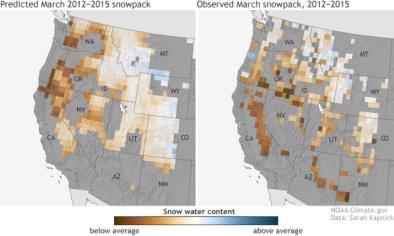Science Source
Is There a Role for Human-Induced Climate Change in the Precipitation Decline that Drove the California Drought?
- States that the recent California drought was associated with a persistent ridge at the west coast of North America that has been associated with, in part, forcing from warm SST anomalies in the tropical west Pacific
- Considers whether there is a role for human-induced climate change in favoring such a west coast ridge
- Finds that reanalyses show that over the last century there has been a trend toward circulation anomalies over the Pacific–North American domain akin to those during the height of the California drought
- States that the trend has been associated with a trend toward preferential warming of the Indo–west Pacific, an arrangement of tropical oceans and Pacific–North American circulation similar to that during winter 2013/14, the driest winter of the California drought
- Finds, however, that these height trends are not reproduced in SST-forced atmosphere model ensembles
- Finds, in contrast, idealized atmosphere modeling suggests that increased tropical Indo-Pacific zonal SST gradients are optimal for forcing height trends that favor a west coast ridge
- These results allow a tenuous case for human-driven climate change driving increased gradients and favoring the west coast ridge, but observational data are not sufficiently accurate to confirm or reject this case
Related Content
Science Source
| AMS Journal of Hydrometeorology
Indications for Protracted Groundwater Depletion after Drought over the Central Valley of California
S.-Y. Simon Wang
Science Source
| Bulletin of the American Meteorological Society
EEE 2013: Causes of the Extreme Dry Conditions Over California During Early 2013
Hailan Wang and Siegfried Schubert
Science Source
| Nature Climate Change
California from drought to deluge
S.-Y. Simon Wang, Jin-Ho Yoon, Emily Becker and Robert Gillies
Headline

Jan 25, 2018 | NOAA Climate.gov
In some places, experimental NOAA models could have predicted Western snow drought eight months in advance


